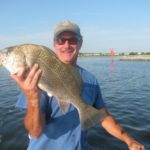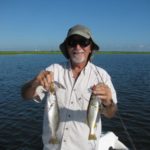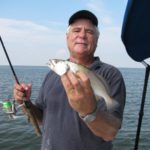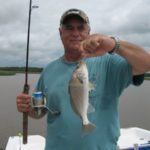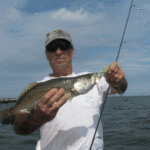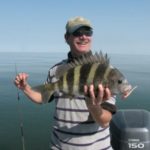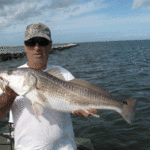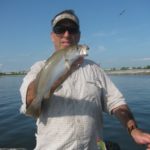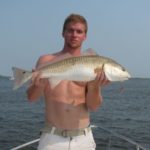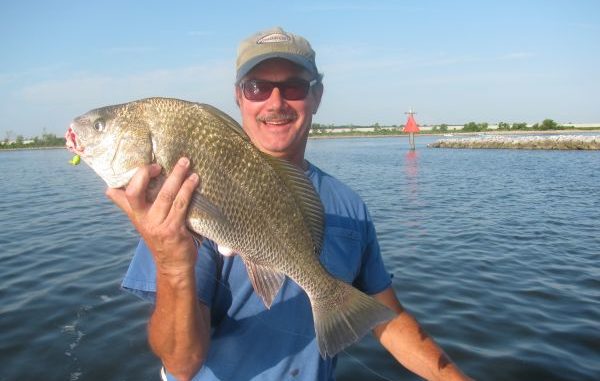
Summertime doesn’t mean making long hauls, if you know a few deep holes on the MRGO.
The trip looked doomed. It always happens this way. The prospects for the morning’s fishing trip always decrease in direct ratio to the number of wine corks popped and trips to the keg. When Doc cranks up “Shattered” by the Rolling Stones, the plans are seriously tail-spinning.
“So we’ll leave a little later,” Pelayo said as he boogied his way past Doc and Trisha on the impromptu dance floor that doubles as Doc’s pool deck. “No problemo. What’s the big deal?”
“Then might as well forget it,” said Artie, blowing off the foam from his cup. “Gotta beat the heat this time a year. That means early, early morning fishing. Dat sun comes out, heats things up and the bite turns off. Come on! I thought we all knew that by now?”
“Right Artie,” Pelayo responded. “But that’s marsh fishing and inside fishing. Because the shallow water heats up. Tomorrow we plan some deep waaaw-da fishing. So no need to get out there before daybreak.”
“Don’t tell me you’re planning another of those long-haul trips to the middle of Breton Sound!” Eddie wailed. “Not another one of those hundred-bucks-of-gas hauls!”
“Nothing like that at all,” Pelayo smirked, while whipping out his iPad. “Check it out. Does this look like a long haul to you?
His Google map was on Chalmette. Then he zeroed on the southern shore of Lake Borgne and the MRGO about midway between what’s now called “The Wall” and Shell Beach.
“Da Castle,” Pelayo blurted. “Remember it, Artie?”
“Ain’t fished it for years,” Artie frowned. “Now with the MRGO blocked off it’s probably even worse than it used to be.”
“Nothing of the sort,” Pelayo clarified. “Actually it means that more fish are concentrated in this passage and channel at Martello Castle. Water drops off to almost 50 feet in that channel connecting Lake Borgne with the MRGO.
“Fish go deep in late winter. And some also go deep in late summer. At least that’s what we’ve hit upon the last few years fishing this area. Big reds, drum, specks, white trout, flounder, croakers — and yes some hardheads and gafftops, too. Ain’t no telling what you’re gonna haul up if you manage to get your bait down about 20 or 30 feet right on the ledge of that deep channel, where it starts dropping.
“Heck you can see all the fish on the fish finder. It’s just a matter of getting your live shrimp, or even shrimp-tipped jig, down to them through the always ferocious current. That’s the key.
This means rigging up almost like fishing the rigs themselves — heavy sinkers along with heavy jigs.”
“See what I got in this bucket,” and I walked over by the burner where Doc had boiled the crawfish earlier and grabbed a bucket.
“While he wasn’t looking, I pilfered a couple pounds of live crawfish from one of the sacks. Here’s my bait tomorrow,” I said, showing the bucket around. “Great way to keep off the hardheads and gafftops. Something grabs a big live crawfish — I pretty much know I’m on a nice red or puppy drum.
“We’ll get a late start. Put up the boat canopy for shade and have ourselves a good old-fashioned meat haul like when we fished the Chef and Rigolets as kids, munched out on whole fried croaker and white trout for dinner. Then watched Morgus the Magnificent.”
Those were the days when bull croakers, puppy drum, channel mullet and white trout were hauled in while bottom-fishing with dead shrimp on shad rigs or plain hooks (not kahle).
Amazingly enough many of these fish were — now hold on to your hats — scaled! (Seen a fish scaler at a store recently?) Then gutted and fried whole.
And they were absolutely dynamite: crispy skin, juicy flavorful interior meat. Amazingly enough, specks were also caught in this manner, but they were rarely the main catch.
“Man, but fishing with the top up is such a pain!” Eddie kept wailing. “Such a pain to cast. Rod’s always bashing the roof.”
“That’s another advantage to this type of fishing Eddie,” added Pelayo. “You’re not winding up and making a long cast to a grassy shoreline or to the current line. You’re mostly dropping the bait over the side, and letting it sink. Kinda like party boat fishing in the old days. Kinda like fishing the Miss Mississippi in days of yore.”
“So y’all got it all figured out for tomorrow,” laughed Doc, who’d been overhearing. “Filling boxes by using live crawfish and maaw-ket bait on snapper rigs while fishing outta St. Bernard where things ain’t hard! And all of it literally made in the shade! Now I’ve heard it all!”
In his classic manner, Doc was telling us he was bugging out of the trip and sleeping in. Trisha grabbed him from behind in a spoon grip at the notification and winked mischievously, as we all nodded.
We launched from Bayou Bienvenue at Bait Inc. elegantly late and well-rested the following morning. Then, we took off like striped apes: up to the Intracoastal, then hung a right to cross the locks, another sharp right along The Wall, then a left at the MRGO.
These locks close on high tides. So if the wind’s been howling out of the southeast for a while you might call the local marinas to see if they’re open. If not, launching at Shell Beach and heading west on the MRGO gets you here in as short a boat ride.
“Look at this current,” Eddie remarked, as we cruised into the channel at what used to be Martello Castle (now basically a rockpile). “Kinda like fishing The Jump during fall. Same thing here. We gotta fight this current to get our bait deep to where the fish are.”
“And look at the depth finder, man.” Pelayo pointed. “Water goes down to 40 feet here. Here’s the ledge.”
Pelayo pointed to the depth finder as Artie went for the anchor.
“Pole anchors are so much easier than these!” he wailed as he hefted Pelayo’s heavy bottom anchor.
“This oyster-and-rock bottom is hard to anchor in. But easy to get snagged in!” Pelayo laughed. “Of course, all those rocks and oysters is what attracts all the bait and the predator fish that come after it.”
“Let’s set up right!” Pelayo insisted, as he grabbed the anchor and instructed Eddie. “Now check the depth gauge and see when we hit the ledge, when the water changes quickly from about 25 to 10 feet or so. We want to fish the ledge. The fish are all stacked up on the ledge.”
The hellacious currents that run through this area have scoured a pretty deep channel. We watched the depth finder go from 5 to 10 to — whooa! — 20, 30 then 50 feet! All within 60 yards or so from the riprap that lines the channel.
“Hold on, hold on!” Pelayo cautioned as he jammed the boat in reverse.
“OK, drop it!” he yelled, and Artie slid the anchor over in an area of 12- to 15-foot depths. “We’ll all be casting that-a-ways!”
Pelayo pointed toward the sloping 20- to 30-foot depths.
The anchor finally caught after two tries, and we let out about 40 feet of rope.
My rig was seriously retro: a 2-ounce “bank-sinker” (in my experience, these slide over the oyster bottom better than pyramid sinkers that often snag up) and a 4/0 hook about 2 feet above it on a loop of the 30-pound leader. Crank up the sizes just a little and I could be rig-fishing from the Miss Mississippi 40 years ago, hauling up bull croaker, white trout and red snapper.
Pelayo, Eddie and Artie were “going downstairs”(as By Hek used to say) with ½-ounce chartreuse tandem jigs Carolina rigged in front of 1-ounce egg sinkers. Tipping them with shrimp isn’t necessary for the trout, but it increases the odds of reds, puppy drum, croaker (and, yes, hardheads.)
The current’s always ripping out here, and today’s big tidal range meant it was ripping faster than usual; otherwise, we might have cranked down our sinker material about an ounce or so.
Two minutes after his first (shrimp-tipped) cast, Artie was muscling in a fish from the depths.
“Fighting hard!” he grunted.
“But fighting steady,” Pelayo frowned. “No lunges. No back and forth. No change of directions — that usually means ….”
Artie’s slime-covered leader soon appeared.
“Told ya!” Pelayo laughed, as Artie groaned.
“Get me the flipper!” Artie snarled, as the big gafftop twirled at boatside.
Then Pelayo reared back and set his hook.
“This one don’t feel like a cat. See these little lunges. This back and forth.” And he raised his rod tip. Indeed.
And about a minute later Pelayo was swinging aboard a pair of frying-sized white trout.
“Yeah!” Eddie yelled from the bow, with his rod high overhead as Artie wiped the slime from his line.
“Whoops! There’s the second one!” and he seemed to set the hook again.
All eyes were on Eddie as, whooping like a lunatic, he swung aboard another pair of trout — one white the other a speck (a pattern that appeared often throughout the day).
“Perfect!” he beamed. “Look at ’em!”
They wriggled and shone in the afternoon sun. In the old days, a speck this size we’d call a “cigar trout.” They were great fried whole — and these would be, too.
Many of the specks we caught would have been borderline legal, right at a foot. The kind you smash and stretch against the ruler, reaching for that magic 12.
With white trout, there’s no such concern (no size or even creel limits). And an added treat: white trout have slender, tender bones to begin with. When it’s a small trout, the bones are all the more tender. Just a little frying pretty much renders them into mush, which means you can suck the luscious white meat off the backbone without much fear of getting a hard rib bone caught in your throat.
My retro-rigged live crawfish went over to laughs and scoffs from Eddie and Artie. I let out about 30 feet of line, reeled in a little slack and could feel the bait bumping along the oyster bottom — and bumping — and — bumping — bumping harder — harder.
Oops, I thought. It’s stuck. I raised the rod tip and felt solid pressure.
“You’re already snagged!” Eddie laughed. “Nice job!”
Then I felt the lunge.
“Pretty lively snag!” I laughed, as I reared back and the drag started singing.
My heavy spinning rod was doubled over as the fish made for the middle of Lake Borgne. My spool emptied, and for a few seconds I thought he might make it.
Finally, I tightened the drag and started gaining on him. I’d gain three cranks, and then he burst off another 10 feet of line. The battle was joined — and it was glorious!
The sight of the copper-colored beauty as Pelayo netted my borderline bull red was equally glorious. And the ones in this area are football-shaped, well-nourished, with luscious marbled meat for the grill!
Artie had been jerking his shrimp-tipped jig vigorously (with this ferocious current, casting and retrieving isn’t as important as simply dropping and jigging) when he let out a whoop. Soon he swung aboard a white trout, smartly smacking my cheek with the free beetle in the process.
And Eddie would have swung in two fish also, but the speck dropped off, leaving him with a chunky bull croaker.
We needed some puppy drum and reds for the grill, so shrimp-tipping prevailed. Eddie cast back out, and reared back the instant he took up the slack. His medium rod bowed deeply.
“Don’t think that’s no white trout or croaker!” Pelayo shouted.
“No way!” Eddie whooped.
“Bet it’s a puppy drum.” Pelayo smirked from the bow.
After a five-minute back-and-forth tussle, I slid the net under Eddie’s drum, about a 4-pounder. Perfect. After about 8 to 10 pounds, in our experience, is when you start finding worms in their meat. So we release big ones.
“We won’t be just frying fish tomorrow folks!” Pelayo roared. “We’ll be grilling some gorgeous fillets on the half-shell, too!”
Three casts later Pelayo had swung aboard three specks. “Watch where I’m casting,” he smirked when Eddie made the observation.
“See?” Pelayo grinned. “I’m casting upcurrent, toward the anchor.”
“OK, big deal!” Artie laughed.
“Now watch,” and Pelayo took up his slack, bounced his rod tip a bit — Wham! “There he is!”
Sure enough, another 16-inch speck was soon aboard.
“Gotta theory here,” he said, chunking his fish in the box. “Trout probably know shrimp don’t swim against a current, at least one this strong. They know such a current usually carries the shrimp with it. So I’m making my jigs do that. Instead of retrieving them against the current, I’m letting them bounce with the current, like a shrimp does naturally.”
Whatever: It sure seemed to work.
No sooner had I put down the net after scooping up another Pelayo trout, I picked up my rod, felt a tap (on my live crawfish) and set the hook on something heavy.
“Feels like another drum here!”
In a few minutes, Pelayo was returning the favor by netting —not a puppy drum — but a gorgeous 8-pound red.
After a couple of hours action slowed, and we moseyed over to the south shore of the MRGO about a quarter mile west from the mouth of Bayou Dupre.
Again we anchored on the ledge. Again we cast into 30-foot depths. And again we caught fish.
By mid-afternoon with the sun — yes — blazing, we could barely close the top on a gorgeous box of meat fish.
